Top News
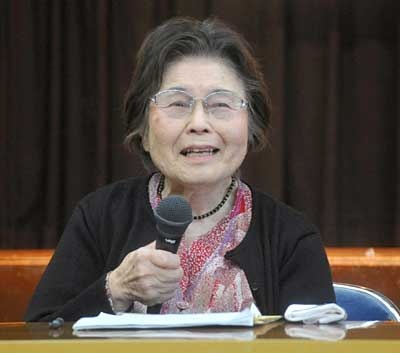
January 28, 2016 Ryukyu Shimpo
Eighty-one-year-old preschool director Toshiko Kinjo is looking for her sister who she was separated from during the war in Saipan. Her sister, Etsuko, was one year old at that time. Kinjo attended a meeting on January 27 in Naha City held by a plaintiff group that claims compensation for victims of the war in the South Sea Islands. Kinjo shared her experience of becoming a war orphan and getting separated from her sister, and she called for information.
Kinjo said, “I came here hoping to meet someone who looks like me. I feel connected to you all, seeing your activities and that you all lived in Saipan as well.” She further reported her story of being cared for by her relatives in Okinawa and not being able to look for her sister after the war, as well as episodes from the past 20 years in which she has repeatedly been mistaken for a Junior high school teacher. She continued, “I hope my sister is alive.”
Seventy-seven-year-old Hideko Soken from Uruma City, who also returned to Okinawa after losing her parents in Saipan, said, “I cannot recall anyone who looks like Kinjo-san, but there are orphans who were taken by Americans as well. I would like to contact them if any information comes up.”
The leader of the plaintiff group, Chieko Nozato, called for more participation at the court where an announcement for state compensation for survivors from the Battle of Okinawa and an oral argument for the compensation case take place on March 16, saying, “Let’s fill the court’s gallery seats.”
If you have any information, please contact Ryukyu Shimpo at 098(865)5158.
(English translation by T&CT and Sayaka Sakuma)
Go to Japanese
February 5, 2016 Ryukyu Shimpo
Japan Self-Defense Forces (SDF) deployments should not be permitted under the justification that they are meant to counter North Korea’s announced missile launch. The important thing in this situation is to make concentrated diplomatic efforts, not raise tensions.
In response to North Korea’s recent announcement that it will launch a long-range ballistic missile, Japan’s Minister of Defense Gen Nakatani issued an order to intercept the missile. The Ministry of Defense (MOD) sent surface-to-air PAC-3 missiles to Miyako Island and Ishigaki Island. A liaison from the Ground Self-Defense Forces has been sent to Yonaguni, also.
Prime Minister Shinzo Abe’s response to the announcement was to say, “I want to redouble efforts to ensure the safety of Japanese citizens.” However, the PAC-3 missiles will be ineffective for intercepting North Korea’s launch this time around. Therefore, it is doubtful that the goal of deploying PAC-3 missiles is actually to provide a safety measure for citizens.
If the launch goes according to North Korea’s specifications, by the time its missile reaches the airspace over Sakishima, it will be outside the earth’s atmosphere and out-of-range of the SDF’s PAC-3s. If North Korea’s plan fails and the missile explodes in mid-air, the PAC-3s will also be incapable of intercepting falling debris.
The PAC-3 missiles system is designed to intercept missiles launched at targets on the earth’s surface. In the case that debris falls from the air, its path will be unpredictable, and therefore interception by the PAC-3s will be impossible.
Military affairs critic Tetsuo Maeda pointed out that, “Whether North Korea’s missile launch succeeds or fails PAC-3s are useless [as a countermeasure].” He expressed his understanding that the MOD is putting on a performance to exaggerate the threat that North Korea poses, and insincerely demonstrate the MOD’s concern for Okinawans’ safety.
The MOD behaved similarly in 2012 when North Korea launched a long-range missile under the justification of using it to launch a satellite. At that time PAC-3s and 450 SDF personnel were deployed to Ishigaki Island, and PAC-3s and 200 SDF personnel were sent to Miyako Island. However, only a liaison group of several people had been stationed on Tarama Island, over which North Korea’s missile actually passed.
From the past behavior of the MOD we can see that PAC-3 deployment is not meant for intercepting North Korea’s missiles. It could be that the act is meant to create the perception that citizens can rely on the SDF.
Currently, Miyako-jima City and Ishigaki City residents are debating the pros and cons of SDF deployment to their locales. If PAC-3 deployment was intended to alleviate many citizens’ negative feelings toward the SDF, this plan should be abandoned.
North Korea’s missile launch announcement was a provocation toward the international community, which drew harsh criticism. However, using the announcement as justification to deploy PAC-3 missiles does not resolve anything. Our first priority should be diplomacy; acting together with the international community to encourage North Korea to exercise restraint.
(English translation by T&CT and Erin Jones)
Go to Japanese
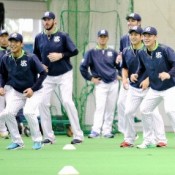
February 2, 2016 Ryukyu Shimpo
On February 1, professional baseball spring training camps began throughout Okinawa. The Hanshin Tigers have begun training in Ginoza Village, the Chunichi Dragons in Chatan Town, the Yokohama DeNA Bay Stars in Ginowan City, the Tokyo Yakult Swallows in Urasoe City, the Chiba Lotte Marines in Ishigaki City, the Tohoku Rakuten Eagles in Kumejima Town, and the Hokkaido Nippon-Ham Fighters in Kunigami Village. There was drizzle, but all teams trained hard in spite of the weather.
Popular players are participating in the training camp of the Yakult Swallows, the infielder Tetsuto Yamada for one. The Swallows won the Central League championships last year for the first time in 14 years. Fans have enthusiastically flocked to the stadium to watch their favorite players train. Players from Okinawa such as Yakult pitcher Nagisa Arakaki and outfielder Wataru Hiyane, and DeNA catcher Hiroki Minei and pitcher Motoharu Fukuchi are taking part this baseball season.
Popular teams are coming to Okinawa this season. On February 16 the Yomiuri Giants come to Naha; on February 17 the Nippon-Ham Fighters will appear in Nago; and on February 20 the Hiroshima Toyo Carp will arrive in Okinawa City. Exhibition games will be held throughout the prefecture on February 20 and 21.
(English translation by T&CT and Erin Jones)
Go to Japanese
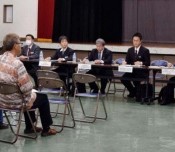
February 1, 2016 Ryukyu Shimpo
Recently, dioxins were detected in the soil at levels exceeding environmental standards in a residential area of the Kamisedo district of Chatan Town. On January 31, at the town chamber of commerce building in Kamisedo, the Okinawa Defense Bureau (ODB) held an information session for landowners in the area. ODB representatives shared with the landowners the content of an interim report based on their investigation into the matter. Around 40 participants attended the information session. Some of the participants requested that health surveys and drilling surveys in other locations be conducted.
The ODB explained that dioxins were detected at levels of 1,800 picograms, which is 1.8 times the level accepted by environmental standards. Regarding others of the 25 other substances that are defined as specified toxic substances under the Soil Contamination Countermeasures Law, the ODB declined to provide information about the specific levels of each substance, merely assuring residents that they fell within the accepted standards.
The ODB declared that it will take the following two measures: (1) Investigate the presence of dioxins in only the top layer of soil (up to a depth of 5 centimeters) in the surrounding area, and (2) Gather information through a survey of relevant documents and interviews, performing additional investigations only if proven necessary. After the information session ended, the ODB provided this information to town council members and reporters.
The representative of the ODB claimed that “at present, there is no risk that dispersion of contaminants will lead to the spread of contamination or pose a threat to human health” and that “there is no immediate health risk unless the soil is dug up.” However, upon further questioning, the ODB stated that these claims are no more than speculation.
Representatives presenting at the information session included ODB assistant administrative director Kazukuni Tamae, Chatan Town chief of general affairs Osamu Tamanaha, and Ryo Matsuda, head of the Okinawa prefectural government’s Special Management Office of Military Installation Environmental Affairs, part of the Environmental Policy Division.
(Translation by T&CT and Sandi Aritza)
Go to Japanese
January 29, 2016 Ryukyu Shimpo
On January 28, findings of an actual condition survey conducted by the Okinawa Prefectural Government (OPG) revealed that Okinawa’s child poverty rate is 29.9 percent. It is the first time in Japan for the poverty rate at a prefectural level to be published. The finding shows that one out of three children in Okinawa is living in poverty. The result highlights that Okinawa’s rate is close to double the nationwide poverty rate of 16.3 percent as last issued in 2012. To deal with this severe child poverty, the OPG is considering establishing a fund of three billion yen.
The OPG collected data about resident-registry networks and residents’ income from all municipalities in Okinawa to calculate the poverty rate and compared the data of eight municipalities with the nationwide poverty rate. In eight municipalities, the poverty rate for children under 18 years old makes up the majority. On January 29, the OPG held a press conference and presented an interim report on the poverty rate and questionnaires completed by elementary and junior high school students and guardians.
The OPG’s fund is available for the prefectural economic development project from the fiscal year of 2016 to 2021. The OPG made a final adjustment to allocate the money for the year 2016. The government’s pending “(Tentative) Child Poverty Countermeasure Promotion Plan” will be decided within the fiscal year of 2015 and executed in 2016. Once the fund is established, it will be reflected in the plan.
“A review meeting group to tackle Okinawa’s child poverty,” which consists of the outside experts to develop a plan, pointed out that municipal support, such as school expense subsidies, has not reached people in need. Using the fund, the OPG is considering supporting municipal projects.
As a countermeasure for child poverty, the Cabinet Office Okinawa is allocating one billion yen from the 2016 project and supports to provide places and assign supporters. Therefore, the OPG is considering projects that do not overlap with the Cabinet Office’s projects.
(English translation by T&CT and Megumi Chibana)
Go to Japanese
December 20, 2015 Ryukyu Shimpo
The U.S. military plans to carry out an exploratory drilling survey for improvement work of a coral runway, a simulated Landing Helicopter Deck (LHD), which is located within the Ie Jima Auxiliary Airfield. On December 19, several pieces of earthenware and fire pit remains that appear to belong to the Jomon period were discovered. The largest of the earthenware was about three centimeters.
A distributional survey carried out in the Ie village did not find the ruin site before the discovery. The planned construction of the LHD will be delayed because a full-scale survey of the site is expected.
The U.S. Marine Corps carried out the exploratory drilling survey at 66 areas on October 2015, accompanied by Ie village officials.
The village officials stated that they solidified a specific plan to carry out the full-scale survey of the site within January 2016.
The post-construction plan states the U.S. Marine Corps will expand its MV-22 Osprey aircraft training program and begin training for F-35 fighters. In addition, the construction drawing shows that the improved airfield will accept CV-22 Osprey that will be deployed to Yokota Air Base in 2017.
(English translation by T&CT)
Go to Japanese
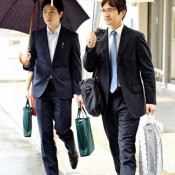
February 2, 2016 Ryukyu Shimpo
On February 1, Okinawa Governor Takeshi Onaga filed a lawsuit with the Naha district branch of the Fukuoka High Court against the Japanese government, seeking to nullify the Japanese government’s decision to suspend his revocation of a landfill permit at Henoko, Nago. This is the third lawsuit between the national government and the prefectural government over Governor Onaga’s revocation of the land reclamation permit. The first oral proceedings will be held on February 15.
The Minister of Land, Infrastructure, Transport and Tourism Keiichi Ishii decided to stop the effect of the governor’s revocation of permission for the landfill, approving an appeal submitted by the Defense Ministry’s Okinawa Defense Bureau, on October 27, 2015. The prefectural government filed a request in November 2015 with the Committee for Settling National-Local Disputes, a third-party organization set up within the ministry, to review the appropriateness of the minister’s decision. The committee dismissed the prefectural government’s request on December 28, 2015 for the reason that it is “not the subject of the examination”.
It is the first time that a local government has filed with the high court challenging a decision made by the Committee for Settling National-Local Disputes since the organization was set up in 2000.
Onaga said, “We would like to assert our view in a straightforward manner.”
According to the written complaint, the prefectural government claims that the appeal submitted by the Okinawa Defense Bureau asking to stop the effect of the governor’s revocation of the landfill permit was illegal because the Administrative Appeals Act is not intended for use by governmental agencies to file appeals requesting administrative review, therefore, the minister’s decision is illegal.
(English translation by T&CT)
Go to Japanese
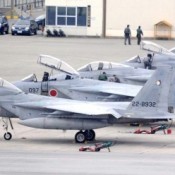
January 27, 2016 Ryukyu Shimpo
On January 26, the Ministry of Defense (MOD) decided to form a new air wing, the 9th Air Wing, at Japan Air Self-Defense Force (JASDF) Naha Air Base starting January 31. Naha Air Base’s 83rd Air Wing will receive 20 F-15 fighter jets from Tsuiki Airfield. With this addition, the 83rd Air Wing will be transformed into the 9th Air Wing. Not only will this decision change Naha Air Base’s collective number of F15 aircraft to 40 in number, but increase their personnel by 300 people. There is concern that doubling the number of fighter aircraft at Naha Air Base will negatively affect tourists flying to Naha, and residents in the surrounding areas.
In addition to forming the 9th Air Wing, the MOD decided to open Japan Ground Self-Defense Force (JGSDF) Camp Yonaguni on March 28 this year. In an interview following a Cabinet meeting on January 26, Minister of Defense Gen Nakatani stated that the MOD is clearly demonstrating that it is strengthening the defense of Japan’s southwestern islands.
In recent years, there has been an increase in the number of scrambles conducted by the JASDF stationed at Naha. The MOD is forming the 9th Air Wing to strengthen the defense of Japan’s southwestern islands. Minister Nakatani is planning a visit to Okinawa on January 31 for a ceremony celebrating the formation of the 9th Air Wing.
At Naha Airport there is only one runway, and it is shared by Japan Self-Defense Forces (JSDF) and civilian flights. Lately, JSDF aircraft that experience trouble have repeatedly blocked the runway. Civilian aircraft are put on standby for JSDF landings and takeoffs, and it is expected that the increase in the number of aircraft flying in and out of the airport will affect civilian flights used by tourists.
In June last year a JASDF helicopter, without receiving directions from an air-traffic controller, crossed the path of a civilian aircraft that was making a takeoff from Naha Airport. Voices from the tourism industry are raising concerns about overcrowding operations at Naha Airport with the projected doubling of fighter aircraft using the runway.
Construction of JGSDF Camp Yonaguni is advancing with a plan to station a JGSDF Coast Observation Unit there.
(English translation by T&CT and Erin Jones)
Go to Japanese
JASDF’new air wing operates 40 F-15s in Naha
January 31, 2016 Ryukyu Shimpo
On January 31, a ceremony commemorating the establishment of Japan Air Self-Defense Force’s 9th Air Wing was held at its base in Naha.
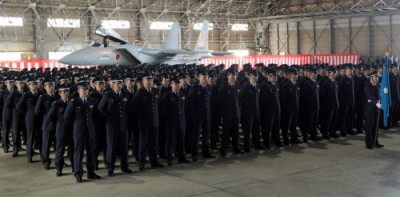
F-15 fighter jets and Japan Air Self-Defense Force’s members newly deployed in Naha, at 11:40 a.m. on January 31.
The 9th Air Wing commander and Naha Base commander Kiyoaki Kawanami received the corps flag from Deputy Defense Minister Kenji Wakamiya.
The new air wing operates about F-15s with 1,500 personnel. Japan Air Self-Defense Force’s 83rd Air Wing, which was set up at Naha base in 1972, was dissolved.
Wakamiya stated in his speech, “We can protect the lives and property of the people as well as securing the territorial land, water and airspace.”
(English translation by T&CT)
Go to Japanese
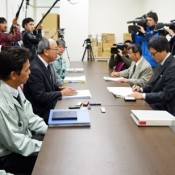
January 21, 2016 Ryukyu Shimpo
PFOS, a fluorinated organic compound and pollutant, has been detected in the water at Chatan Water Purification Plant and Hija River. On January 21, director of the Okinawa Prefectural Enterprise Bureau Toshiaki Taira visited the Defense Ministry’s Okinawa Defense Bureau (ODB) in Kadena Town and requested that the U.S. Armed Forces grant authorization to enter base compounds for investigation purposes. ODB Planning Department Vice-Director Hitoshi Miyagawa replied that the Bureau intends to promptly convey this request to the US Armed Forces.
Taira requested that if the U.S. Armed Forces has indeed been using PFOS, that it quickly halt its use of the organic compound, disclose the background of its use of PFOS, and respond with appropriate measures to address the situation. After making his request, Taira said in a media interview that up to this point gaining access to US base compounds has been difficult. He also mentioned, “In this instance, however, Okinawa residents’ drinking water has been affected, so we hope that [the US Armed Forces] will take a different approach this time.”
(English translation by T&CT and Erin Jones)
Go to Japanese
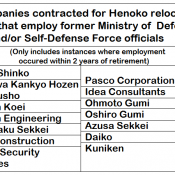
January 22, 2016 Ryukyu Shimpo
During the roughly two years between December 2013 and the end of November 2015, Japan’s Ministry of Defense (MOD) has entered into contracts with sixty-five companies to carry out construction and other works related to the relocation of U.S. Marine Corps Air Station Futenma to Henoko. It has come to light that at least fourteen of these companies employ former officials of the MOD and/or the Japan Self-Defense Forces (JSDF). This was revealed by defense minister Gen Nakatani at a meeting of the Upper House Audit Committee in response to a question posed by Social Democratic Party member Seiji Mataichi. According to MOD officials, however, the fourteen companies revealed in Nakatani’s statement only include the companies at which former government and military officials were hired within two years after retiring from their public positions, so the actual number of companies employing former officials is likely even higher.
According to Nakatani’s statement, between December 2013 and November 2015, the MOD entered into contracts with sixty-five companies for a total of ninety-two works, adding up to a total of around 69.7 billion yen. Around 80 percent of the contracts were won through an open bidding process, while the remaining 20 percent were private contracts involving no bidding process. Nakatani claimed that “the construction contracts were made fairly in accordance with relevant regulations, regardless of the former status of the companies’ employees.”
MOD regulations stipulate that when a former MOD official is hired by a private company within two years of retirement, the MOD must carry out a special screening in order to avoid issues of pork-barrel politics. MOD records of these screenings show that over the past ten years, former officials have been re-hired at fourteen private companies within two years of retirement. However, the MOD has no duty to report the employment of a former official at a private company if it occurs more than two years after his or her retirement from the Ministry, and declines to do so.
The Ryukyu Shimpo’s investigations have found that of the corporations and foundations contracted to do work on the Henoko base construction, even more than the recently revealed fourteen companies employ former MOD and JSDF officials. These officials often claim that the company placed them in advisory and other executive positions due to the expert knowledge they acquired at the MOD.
In response to the Ryukyu Shimpo’s questioning, some companies have declined to clarify whether they employ former MOD or JSDF officials, citing privacy reasons. The relationship between companies’ employment of former defense officials and the Henoko relocation construction contracts remains opaque.
(English Translation by T&CT and Sandi Aritza)
Go to Japanese
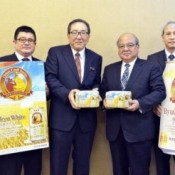
January 26, 2016 Ryukyu Shimpo
On January 26, Orion Breweries Limited will start selling its “Ryukyu White” happoshu, which uses Iejima-grown wheat. This is the first time for an Orion product to be brewed using mainly Okinawan ingredients. Ryukyu White is a craft beer variant, utilizing special materials and brewing techniques to achieve a fruity aroma and spicy flavor. The beer will be on sale in limited quantities.
In addition to Okinawa, the beer will be shipped to Washita shops around Japan as well as some parts of Hong Kong.

“Ryukyu White” uses wheat native to Iejima
Ryukyu White is the second product in the Orion Craft Series. In addition to malt and hops, the beer uses “Eshima Jinriki,” a type of wheat native to Iejima. The wheat, which has a delicious aroma, is combined with orange peels and coriander seeds. The open price is expected to be somewhere between 220 and 230 yen. In total, 494,000 cans of Ryukyu White will be sold, with each can containing 350 milliliters.
Iejima wheat was grown for personal consumption until 2012. That year, sixteen farmers came together to establish the Wheat Production for Business Association. Their initiatives, which include collaborative product development with companies, are expected to bring a 3.5-fold year-on-year increase in production for this fiscal year. This is equivalent to a yield of 60 tons.
At the press conference, held on January 25 at the Okinawa Prefectural Government (OPG), Ie Village Mayor Hideyuki Shimabukuro commented, “I hope this product promotes a lifestyle to produce and eat locally and serves as a model for further product development with companies. If this proves a success, we would like to continue with this series of wheat products.” Vice President Masamitsu Arakaki said, “We developed this product in the hope of contributing to the community. I think we’ve managed to satisfy the taste buds of the locals too.”
(English Translation by T&CT, Kaya Doi)
Go to Japanese










 Webcam(Kokusai Street)
Webcam(Kokusai Street)


